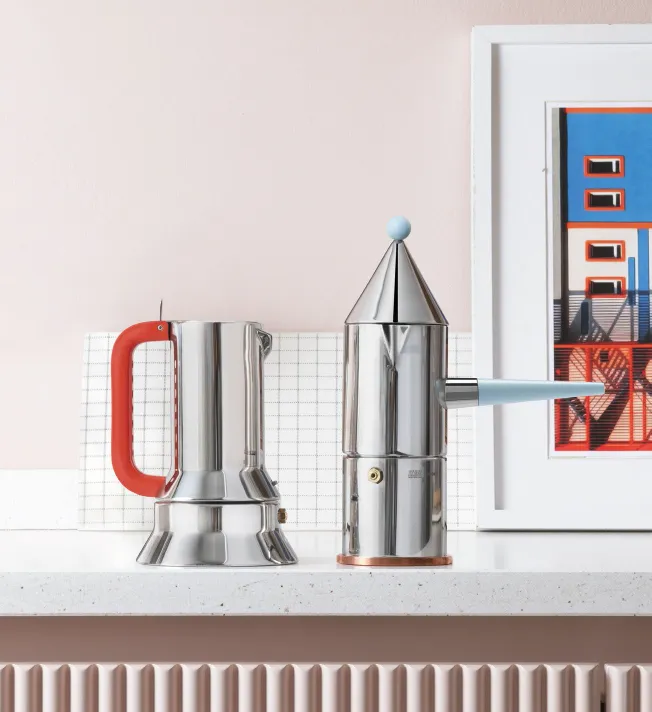
Conica “long handle” espresso coffee maker by Aldo Rossi, and model” 9090 perforated handle” by Richard Sapper.
The evocative power of the kitchen is unique to this space and to no other room in the house. This domestic area represents the very essence of “convivialité”, which from time immemorial focuses on the table, where foods and rituals take on a symbolic meaning, and are intimately connected to ancestral traditions passed down through generations. Food, as the key element of the table, combines nutritional values with a higher dimension, less mundane, which symbolism, under the social perspective, has evolved over time. The design objects of modern, domestic convivialité physically explicit this evolutionary process.
Italian iconic brand Alessi has just celebrated its 100th anniversary. During its long history it has created unique objects that embody, in a unique and distinctive manner, the intimate bond between design and conviviality.
“Alessi’s mission has always been to bring art and poetry into everyday life, in which social interaction is strongly linked to food and its sharing”, says Carlo Gasparini, the company's design manager and fourth generation Alessi.

Above and below, David Chipperfield’s 2019 Moka is a tribute to Italy’s most popular espresso coffee maker ever and to its inventor, Alfonso Bialetti, Alberto Alessi’s grandfather.
How did this concept of sharing evolve over time?
One of the macro-trends which Alessi addressed in terms of product design, is the transition from a typically European idea of the kitchen as the formal place to prepare and eat food, to one of a space for creativity and sharing. In the past, the kitchen was essentially the realm of the housewife who prepared food for the whole family, who ate it sitting at the table according to conventions. Today it is the place for sharing experiences, in addition to actually eating. The new ritual may start with a glass of wine, and continue with an aperitivo while preparing the meal.How did this process impact domestic objects in terms of product design?
Social changes in the consumption and enjoyment of food brought about the natural evolution of the objects serving this specific purpose.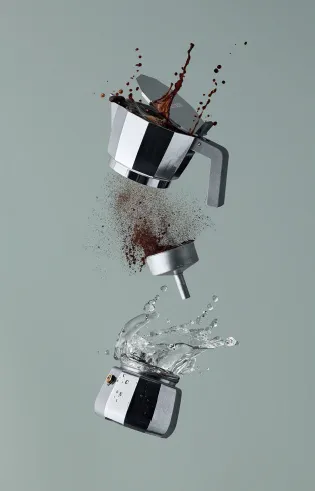
Can you make some examples?
The mise en place, i.e. the table setting, has changed: the plates destined to the single courses have been replaced by an archipelago of vessels and trays from which one can pick different foods, originating from various culinary cultures. Today, the table has become the territory of cultural exchange and socialising, favoured by the informal enjoyment of food: smaller plates and contained portions of different foods, often the result of cultural cross contamination, to be sampled and talked over. We have gone from an individual pattern of consumption to one of sharing, a trend that will grow stronger in the coming future. Hence an increased demand for flexible and creative objects that can support the fusion of flavours and recipes.
Carlo Gasparini, design manager, represents the fourth generation of the Alessi family. With an academic background in architecture, he is responsible for product development as well as acting as an intermediary between the creative professionals and the technical department.
If you were to name two Alessi products to represent the current food sharing trend, what would they be?
Certainly the moka, both because it is a pop product par excellence, also in terms of commercial success, and because it represents the embodiment of the ritual of sharing, intended as an archetype of conviviality that lives on in our modern days. The moka coffee maker is having a great comeback: after years of fast coffee with the absolute domination of coffee pods, today we have gone back to slow coffee and its rituals, starting with the enjoyment of the bewitching fragrance preceding coffee itself. To be honest, it needs to be said that Alessi has strong ties, even blood ties, with the object as my great grandfather, Alfonso Bialetti, was the inventor of the first “caffettiera espressa” at the beginning of the 20th Century.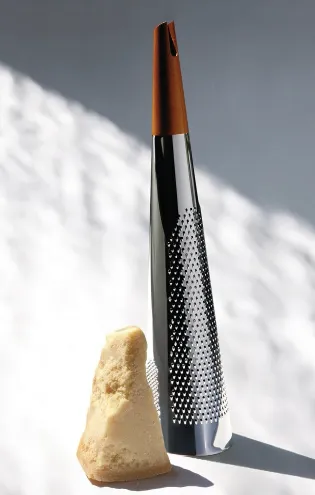
Todo the giant grater, designed in 2004 by Richard Sapper, is an example of an object to be put on display on the table or in the kitchen, but which performs at the same time in a precise and innovative way, transforming one of the most boring culinary actions into a playful act.

The Ottagonale collection, designed by Carlo Alessi in 1935, is among the historic products recently reedited and represents one the most fitting archetypes of past conviviality, and an Alessi all-time classic.
What about the second product?
It’s the Moscardino multipurpose utensil, the true emblem of food sharing, designed in 2000 by Giulio Iacchetti and Matteo Ragni specifically for the aperitivo and combining, in a single instrument, the functions of a fork and a spoon. It perfectly addresses the changing habits in eating and entertaining.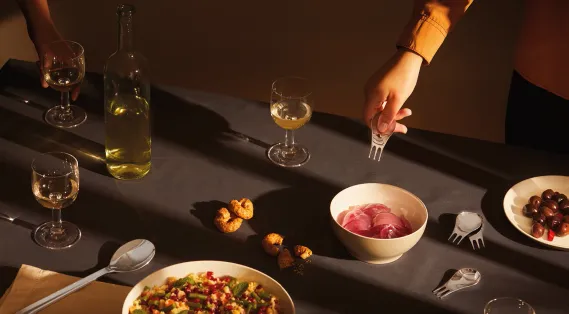
The emblem of food sharing, the Moscardino multipurpose utensil was designed for eating a meal quickly, for a standing lunch, for an informal aperitif or for serving small bites and finger food in a new and original way.
How do you think the design of table utensils will evolve in the next future?
It will undoubtedly go towards a growing convergence between the design world and the IOT, a combination we are already working on at Alessi.A significant change of paradigm is underway: up until today, it was us who knew the objects, but now it is the objects that start knowing us, thanks to sensors and smart capacities. “Intelligent objects” learn to know the users, which will enable them to better manage their social interactions within the home. In the near future AI will bring about new types of conviviality and sharing.
Is this good or bad?
It's certainly good inasmuch these objects will allow people to have more time to interact with each other, boosting their social lives.Do such objects already exist?
The smart cooker comes to mind, and the voice assistant, too: the former can take care of practical tasks in your place, freeing up some time for you to devote to more rewarding activities, while the latter can gather people around a recipe they can do together. Actually, the future is yet to be created.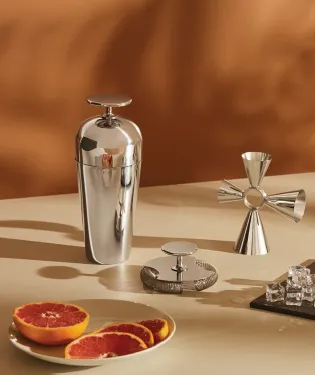
The Tending box is the new collection of cocktail accessories designed by Giulio Iacchetti under the expert advice of mixologist Oscar Quagliarini. The home mixology trend started during the pandemics, and represents a perfect example of contemporary conviviality.
ALESSI
THE DREAM FACTORY

→www.alessi.com
Copyright © Homa 2023
All rights reserved

.jpg?VGhlIFBlcmZlY3QgU2xvdC1pbijmraPnoa4pLmpwZw==)

































